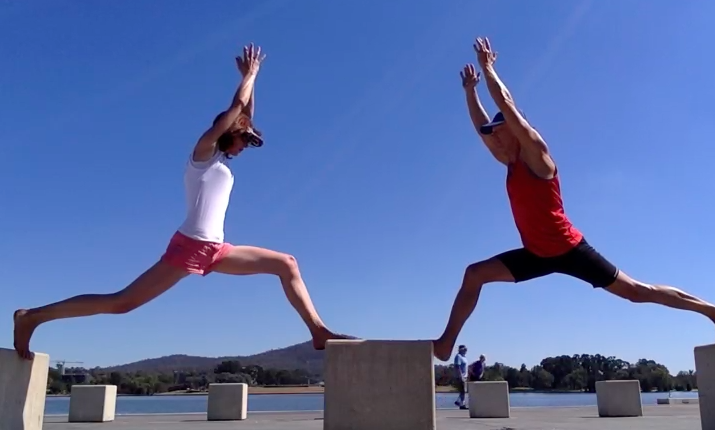Even though handstands and arm balances feature in most of my sequences, not all of us can do a handstand. Sometimes, for whatever reason, we might not be able to put our hands on the ground either.
But all of us can learn some of the key actions of a handstand without putting our hands on the ground.
In this post I share a video and some instructions about some of the key actions that you can cultivate so you are still working towards similar 'anatomic' actions.
You could take this option when it gets to an arm balance section of the class and still be doing amazing energy moving work.
Have a look at the video to see the movement in action, then take a look at how I have tried to deconstruct the steps.
Soft Tummy
One of the keys here is to be able to have a soft tummy. If you cannot relax your tummy then you very likely may not create the correct firmness in the tummy when the time comes to do so.
 |
| Digging fingers into soft tummy to show it is soft |
This is trickier than you might think. Most people find it really difficult to relax tummy muscles. It can be for many reasons. One of the key ones I have come across is the perception that we should be sucking our tummy in and walking around with sucked in tummies as much as we can.
Be aware that if you cannot relax your tummy muscles, you are putting fairly constant pressure on the contents of your abdomen, including your bowels and reproductive organs. This can impact on the functioning of the digestive and reproductive systems.
Anyway, just a thought.
So, step one is to relax your tummy completely. In the photo and video I try to show this by digging my fingers deep into my tummy so you can see it is not hard.
Lengthen lower back
In general I start many postures by moving my sitting bones down, top of pelvis back in order to lengthen my lower back.
I took my arms overhead in the photo/video so you could see what I am doing. It is also a nice thing to do to enhance the length of the back of spine.
I am not doing this action by tensing my tummy. There is a little lower abdominal internal activation but generally the tummy is very soft still. In the video I dig my fingers back in my tummy to show this.
Push hips/sitting bones forward without moving legs forward
This is tricky. You try to push your hips/sitting bones forward without moving the legs forward.
If the legs go forward you don't get the firmness in your tummy.
If the legs remain as much as possible where they are then the tummy goes firm.
In the video you can see that I push my fingers into my tummy after this and they cannot go in. It is firm. I try to show this below as well.
My tummy is firm in a way that I can still breathe freely and feel as though the movement of the breath could go there.
If you watch my arm balance videos where my abdomen is exposed you can sort of see that my breath is still going into my abdomen area (looks like I have gills!).
This is not sucking in tummy. If you slow the video down where I push hips forward you can see that I am not sucking up.
Push armpits down and forward
Push the armpits down and forward.
In the video I show how this firms the front and back of the armpits.
My tummy is still firm.
The movements I do in the video are really exaggerated and jerky. I was trying to emphasise what I was doing. If I did my own practice these actions would be much more subtle.
Alternate firming of armpits and tummy
Because I have been practicing these activations for a while, I can do them as shown. I showed this way more for the video so you could see what I am doing.
If you are learning this, most people will find getting armpits and tummy firm easier if they try putting the arms on the thighs as shown in the picture below.
If I was in a class, I would be encouraging people to use this method as pushing the hands against the thighs helps prevent them from coming forward when you push the hips forward. Also, it is easier to get some armpit activation for many people if the hands have something to press down against.
In class I usually do the demonstration as shown in this photo and get people to feel what is going on.
Stay or take these activations to the ground
These two activations are key components (but not the only ones) of many postures (?most) where you are weight bearing through the arms.
If you don't want to or cannot put weight through your arms for some reason then you could be doing this and really feel like you are doing something. You could do it from kneeling if you want as well.
If you can, you could try to take these activations to the ground for plank, kneeling plank, bakasana, or even a handstand.
But remember, your life will not be any better just because you can do a handstand!
It will probably be better if you can learn to relax your tummy completely then learn to activate it when you need however!
Don't do anything that hurts. Be alert to over practicing and how you feel the next few days whenever you introduce new practices. Have fun. Laugh. Smile.
Happy and safe practicing.






























